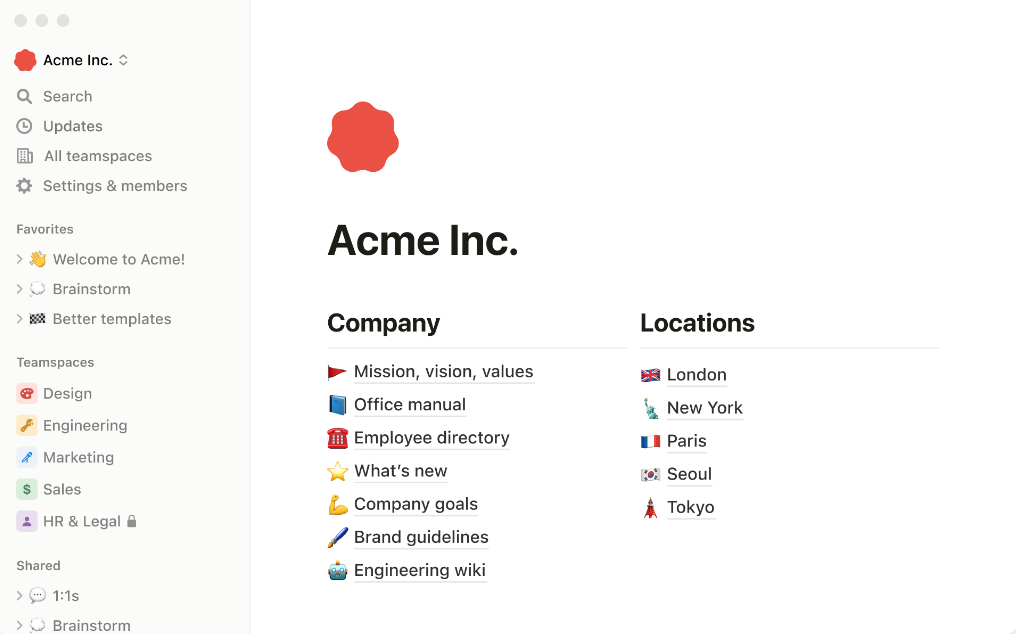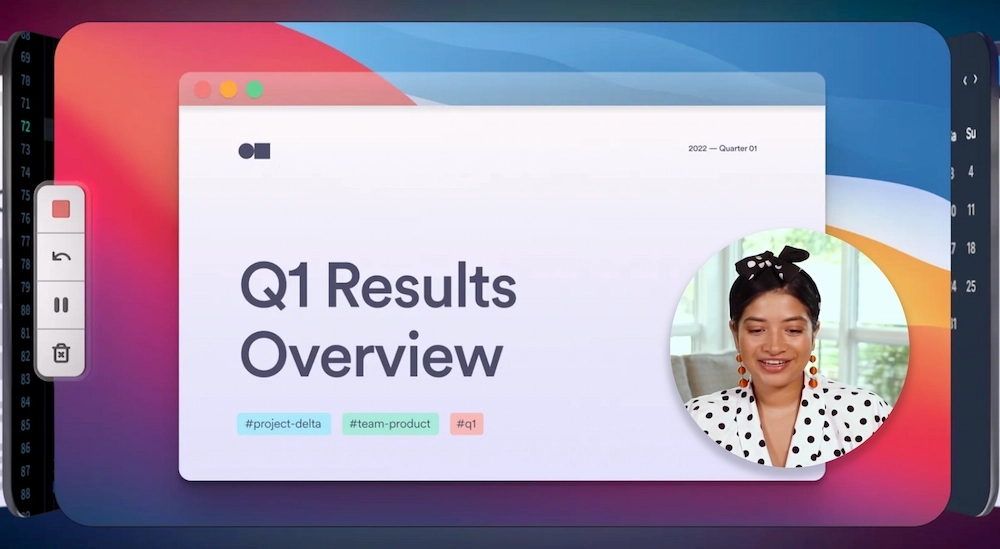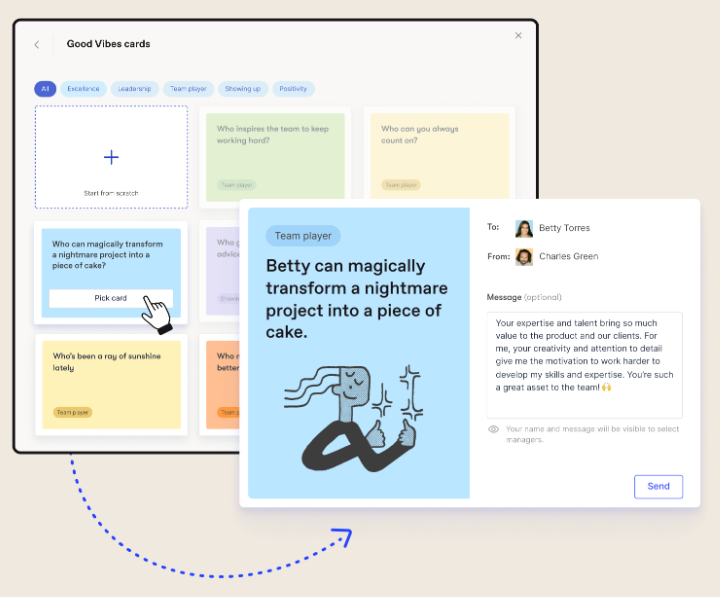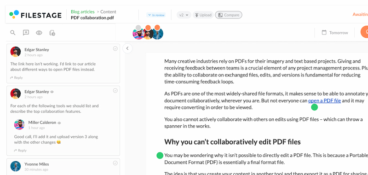Asynchronous collaboration is all about working when and where you feel most effective. This gives you the freedom to have a more flexible work-life balance without compromising on the quality of your work. And it’s even been shown to fuel creativity.
Filestage is an asynchronous, fully-remote organization with people all over the world. (Even in the marketing team, we’re covering time zones from Mexico to Bali.) And since I’ve been working here for three years now, I feel pretty well qualified to share some lessons about how to do asynchronous collaboration right.
So here’s my roundup of lessons from people who actually do it. I’ll share some asynchronous collaboration examples so you can see how we do things at Filestage. Plus some tips on the best asynchronous communication tools to help you out along the way.
Let’s go!
1. Set ground rules on the right asynchronous collaboration tools for different scenarios
Have you ever found yourself baffled by the sheer number of asynchronous communication channels your collaborators use?
You’ll have a Trello board for tracking your tasks, but someone will share an update via email. Or you’ll have a document with comments from various teammates, but one person decides to share a brain dump with you directly in Slack.
This is frustrating enough when juggling synchronous communication channels like video calls and meetings. But when you’re working asynchronously, you need to help each other out by communicating consistently. And that all comes with setting some ground rules.
Here are a few examples of how we use asynchronous collaboration tools at Filestage:
- Asana – for assigning or sharing updates on specific tasks
- FigJam – for asynchronous workshops and brainstorming sessions
- Slack – for discussions and updates that don’t relate to specific tasks
- Loom – for presenting work or sharing how-to videos that can be rewatched
- Filestage – for collaboratively reviewing videos and designs
By setting guidelines like this upfront, you and your teammates can enjoy smooth and streamlined digital collaboration – minus the headaches.
2. Align on deadlines and dependencies with a project management tool
When you’re working across different locations and time zones, it’s sometimes difficult to see the big picture. You’re in your own space, doing your own thing in your own time, and so is everyone else – right?
But of course, that’s not the case. Sure, some tasks and projects are solo efforts. But when it comes to asynchronous collaboration, there’s a chain of events that takes you from idea to completion. And to manage that effectively while enjoying the benefits of asynchronous collaboration, you need – and I mean need – a project management tool.

Image: Asana
Before I explain why, let me share a quick anecdote.
I know an asynchronous team who don’t use project management software for managing tasks. This means there are no expectations for when one task will be finished and when the next will be ready to start. So when tasks do eventually pass to the next person in the chain (from the copywriter to designer, for example), they’re often busy doing something else. This causes delays of days, if not weeks, and projects that should take a week or two end up taking months.
With a project management tool, you can set out all your deadlines and dependencies up front. This gives everyone a clear expectation of when they’ll need to step in to do their part.
Here’s a simple example of how we do this at Filestage:
- Jan 8 – Share best practice research for the new web page (whole team)
- Jan 10 – Create a wireframe for the new web page (designer)
- Jan 11 – Write copy for the new web page (copywriter)
- Jan 12 – Design the new web page (designer)
- Jan 15 – Review the new web page (whole team)
- Jan 16 – Finalize web page design (designer)
- Jan 17 – Hand over web page to developers (marketing manager)
3. Give plenty of context when briefing tasks to avoid being a blocker
If content is king, then context is queen – especially if you want to support asynchronous collaboration.
Picture the scene: you’ve been briefed to work on a last-minute design task by one of your colleagues. It needs to go to the printers tomorrow ready for an event next week. But they haven’t included specs like crop and bleed marks. You don’t even know what size the design needs to be.
The trouble is that, by the time you realize this, your colleague has long since finished for the day and is tucked up in bed. This means you can’t do anything until they’re back online tomorrow.
Here are two tips to help you avoid this situation:
- Give as much context as possible when assigning tasks in your project management tool
- Ask the assignee to read the task before you sign off in case they have any questions
Trust me, you’ll thank me later!
4. Set up a consistent process for your content reviews
If you’re collaborating on designs, videos, copy, or any other types of content with your team, you’ll probably need feedback and approval at some point.
This can be particularly tricky using traditional asynchronous channels and collaboration tools. Between email chains, spur-of-the-moment meetings, and chat threads, key stakeholders and opinions can easily get missed. So it’s important to have a consistent process in place – and Filestage can help with that.
Filestage lets you set up a review and approval process for your project, turning complex review rounds into a simple step-by-step workflow. So once your project is set up, you can loop in the right stakeholders at the right times and collect collaborative feedback across all your files and versions.
Here’s an example of what your workflow may look like:
- Creative review – writer, designer, video editor, creative director
- Marketing review – marketing manager, brand manager
- Compliance review – legal specialist, regulatory expert
Supercharge your project collaboration
Share, review, and approve all your content in one place with Filestage.
5. Build a resource hub so people can answer their own questions
Have you ever had a question at work that you couldn’t answer because someone was on holiday?
With asynchronous collaboration, where everyone’s working hours are slightly different, this can happen daily. You can’t get something done because the person with the answers has finished for the day, so you have to wait until tomorrow.
Once in a while, delays like this aren’t a big issue. But still, wouldn’t it be better if people could find the answers they need when they need them?
Using a knowledge management platform like Notion or Google Sites, you can create a resource hub that lets people search for answers – just like they would on Google. It can include text, how-to videos, and links to forms and documents, like one big digital handbook for your company.

Image: Notion
Here are some examples of what yours could include:
- How to submit an invoice
- How to hire a freelancer or supplier
- Where to find your brand logo and fonts
- The company policy about taking time off
- How to submit a request for new software
6. Run workshops and share ideas using a whiteboarding tool
When people talk about the benefits of the office and real-time collaboration, they always say that it’s essential for sharing ideas.
I disagree.
As an introvert, I’ve always found real-time, face-to-face brainstorms pretty difficult. Everything would be steamrolled by the loudest people in the room, and I’d always have my best ideas after the session.
Since switching to fully asynchronous work three years ago, I’ve found my workshops to be far more effective and collaborative. And that’s all thanks to a tool called FigJam. It’s essentially a big digital whiteboard that people can access and add to whenever it suits them.

Image: FigJam
Here are a few ways we use FigJam at Filestage:
- Project kick-offs – bringing everyone together to align on roles and responsibilities
- Brainstorms – running asynchronous post-it exercises to collect ideas from the team
- Retros – looking back on the quarter to assess our wins and losses
7. Use announcement channels to share progress about milestones
From grabbing coffee in the kitchen to overhearing conversations at your desk, news travels fast in an office environment. So if you want to run a successful asynchronous team, you need to embrace the idea of over-communication.
One great way to do that is by setting up announcement channels in Slack, Microsoft Teams, Discord, or wherever else you discuss your work.
This gives your teammates dedicated spaces to share what they’ve been up to each week. Not only does this create transparency between departments, it also reminds everyone that they’re part of a much bigger whole.

Image: Slack
To give you some inspiration, here are a few announcement channels we have in Slack:
- mkt-announcements – for posting about new web pages, articles, and other marketing initiatives
- people-announcements – for sharing new policies and culture updates that affect everyone in the company
- prod-announcements – for shouting about new features in our product
8. Share updates without meetings using a screen recording tool
Meetings suck. They’re often mandatory, and too many of them are unproductive. In fact, in the US alone, unnecessary meetings waste $37 billion in salary hours every year.
But meetings do have one virtue: the ability to show and tell. So if you really want to enjoy this benefit of synchronous collaboration, you need to find another way.
This is where tools like Loom, Vidyard, and Wistia come to the rescue. They allow you to record yourself and your screen at the same time, then you can share the videos with your team – wherever they are.

Image: Loom
Here are a few ways we use screen recording tools at Filestage:
- Pitching ideas – giving video walkthroughs about new initiatives
- Presenting work – sharing context so people can give the most useful feedback possible
- Tutorials – creating how-tos for our processes for new team members to follow
And, as someone with a brain like a sieve, these tools have one big benefit over meetings for remote teams: rewatchability. So if you forget what someone said or just need a quick recap, the answers are only a click away.
9. Take advantage of time zone differences
The key to effective asynchronous collaboration is approaching it with the right mindset. For some companies, having people spread across different time zones is a headache. Instead, they want everyone online between core hours in their main market – usually 10:00am to 4:00pm.
But the teams who do asynchronous collaboration best turn this on its head. Rather than seeing this time misalignment as a problem to solve, they see it as an opportunity to take advantage of.
This is exactly what we do at Filestage. I’m a writer based in the UK and our designer is based in Mexico. This means that, when I’m done for the day, he has another six hours to go. And it also means that I’ve got a good three or four hours of writing time the next morning before he starts again.
So, with a little help from asynchronous collaboration, this expands our combined working day to around 14 hours. And rather than letting our time differences block us, we use them to get more done in the same number of days.
10. Keep people motivated by celebrating their wins
Last but by no means least, I have one final asynchronous communication tip for you.
Despite all the benefits of remote work like managing your own time and living the digital nomad life, asynchronous collaboration can be isolating. And, over time, that isolation can be pretty demotivating – especially if you don’t feel like your work is being valued.
With synchronous collaboration, especially in an office, praise and recognition tend to happen automatically. But in a remote work environment, you need to be a bit more deliberate when it comes to celebrating your teammates.
Here are a few ways we do this at Filestage:
- Give public shoutouts in our monthly all-hands calls
- Tag people to praise their contributions in our announcement channels (see number seven)
- Send a good vibes card to a teammate using OfficeVibe

Image: OfficeVibe
Final thoughts
Thanks for taking the time to read my 10 lessons on asynchronous collaboration. I hope they offer some value for you and your team, whether you work from the office, remotely, or engage in hybrid collaboration.
I guess it all comes down to being mindful of the people you’re working with. Give your team members the tools, training, and context to do their best work and keep everyone in the loop about it. And if you’re a big team spread across multiple time zones, use that to your advantage!
One more thing – if you need a better way to manage content reviews and approvals asynchronously, Filestage can help. So why not start a free trial today?










